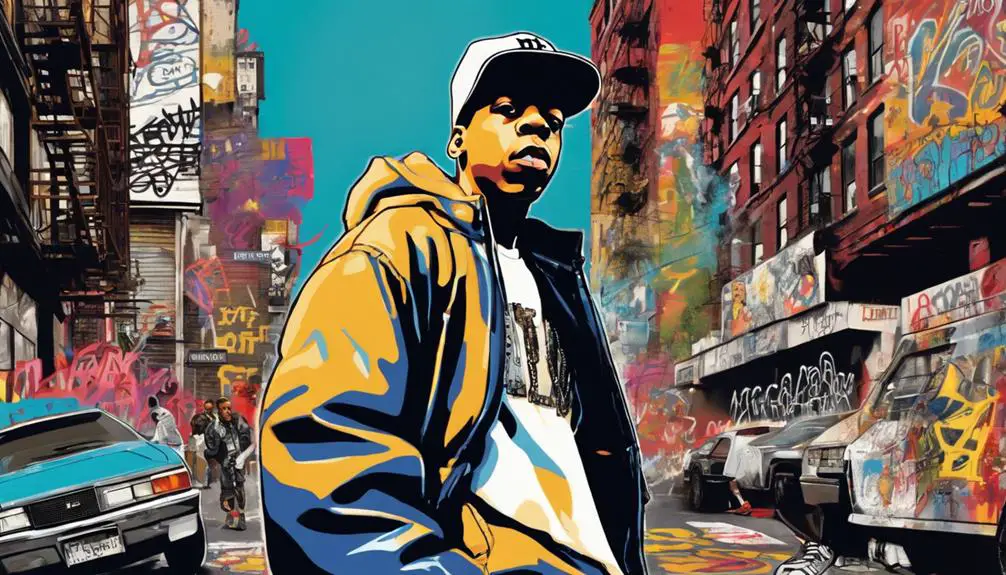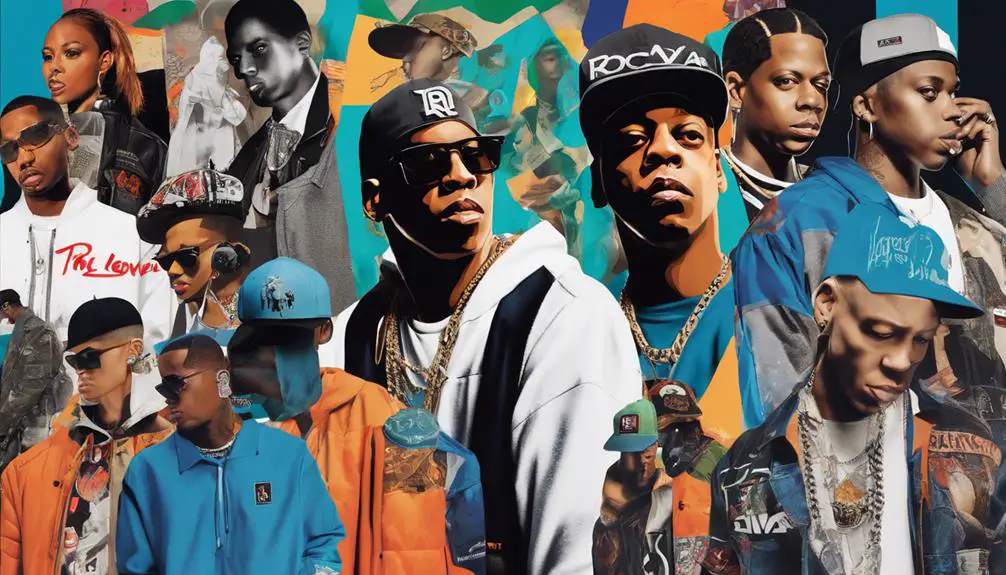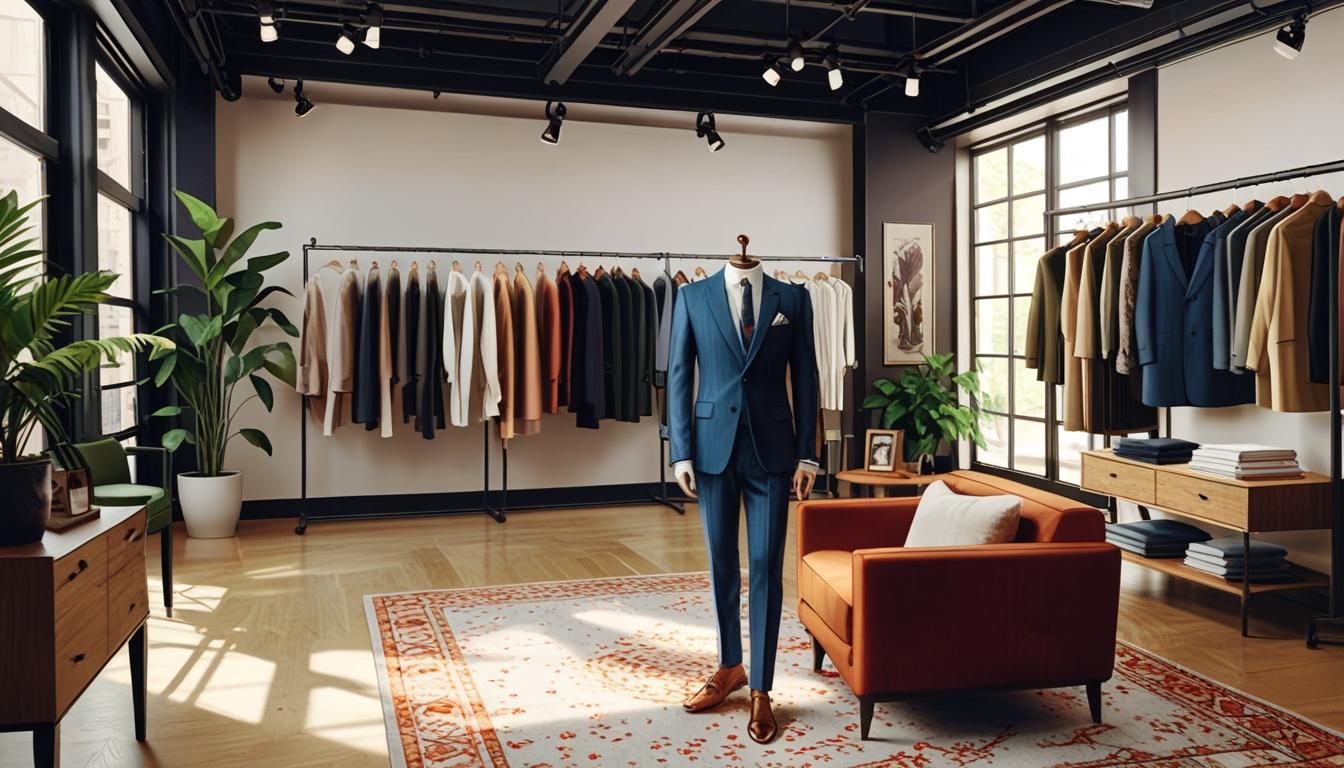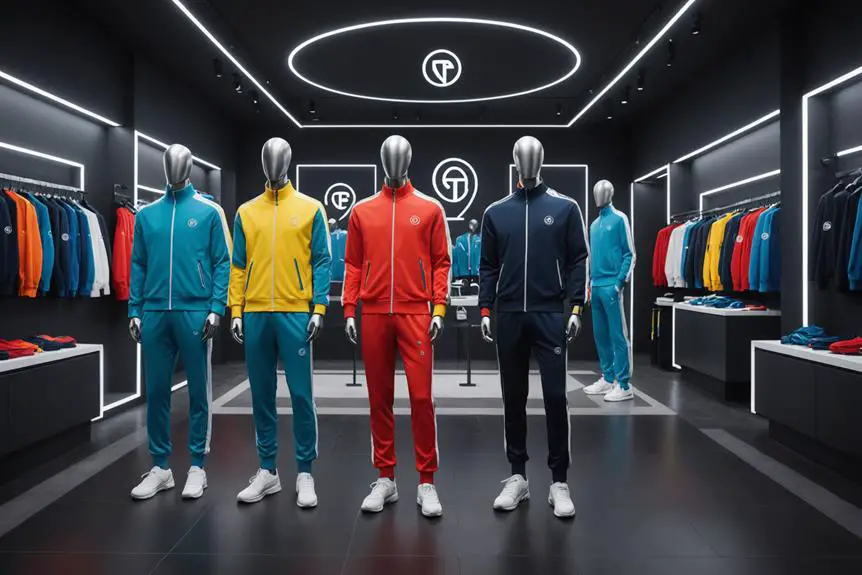You might be surprised to learn how Rocawear, established by Jay-Z and his partners in 1999, evolved from a modest venture into a multi-million dollar fashion empire within just a few years. As you delve into its story, consider the brand's distinctive approaches that not only embodied the essence of hip-hop culture but also revolutionized the urban fashion scene. What elements contributed to its rapid ascent and lasting impact? The insights you uncover may reveal more about the convergence of music, style, and commerce than you might anticipate.
Founding and Early Development

In 1999, Rocawear burst onto the fashion scene as a subsidiary of Roc-A-Fella Enterprises, founded by Jay-Z, Damon Dash, and Kareem Burke. This collaboration among three influential figures set the stage for a brand that would revolutionize urban apparel! The inspiration for Rocawear emerged in 1997 when Jay-Z identified gaps in the market. He recognized an opportunity to serve the hip-hop community, which was eager for stylish clothing that resonated with their culture. This journey is reminiscent of how brands like Billabong transitioned from local origins to global prominence, highlighting the importance of brand identity in the fashion industry.
Starting from humble beginnings, Rocawear produced its first T-shirts right in the Roc-A-Fella offices. With Jay-Z's influence in the hip-hop realm and strong backing from investors, Rocawear quickly gained momentum. By 2005, sales soared to an impressive $700 million, showcasing remarkable growth in a short time.
Rocawear transcended being merely a clothing line; it became a representation of the spirit and energy of the hip-hop lifestyle. It filled a crucial niche that was eager for recognition and did so with undeniable style. With minimal competition in the urban clothing market at the time, the brand seized the opportunity to shine. Rocawear's influence permeated various facets of culture, from the streets to music videos, solidifying its status as a household name. So, when you think of Rocawear, remember it's not just a fashion brand; it's a cultural phenomenon!
Market Position and Success
Success in the fashion industry often hinges on a brand's ability to resonate with its audience, and Rocawear exemplified this principle by becoming the most profitable brand in hip-hop history. With an estimated worth exceeding $500 million by 2007 and sales surpassing $700 million by 2004, Rocawear really set the bar high. This success mirrors the journey of other iconic brands, such as Tommy Hilfiger's cultural impact during the 1990s, showcasing the importance of aligning with cultural movements. So, what's the secret sauce behind its profitability?
- Licensing Agreements: Rocawear strategically employed these agreements to maintain a steady revenue stream, even as fashion trends evolved.
- Strategic Partnerships: Collaborating with major retailers like Macy's significantly enhanced its market presence, making the brand more accessible to fans.
- Urban Apparel Focus: By remaining true to its roots in urban culture, Rocawear cultivated a devoted following that firmly established its place in the market.
Marketing and Branding Strategies

When you think about Rocawear, you can't help but notice how their celebrity endorsements really make the brand pop! From music videos to community events, they've created a vibe that connects with people on a personal level. This strong connection to hip-hop culture and lifestyle has been essential in reinforcing their brand identity. Rocawear's innovative advertising campaigns, emphasizing their unique heritage, and community engagement strategies helped shape their identity. So, how did these approaches contribute to their success in the fashion industry?
Celebrity Endorsements Impact
Celebrity endorsements have been pivotal in shaping Rocawear's marketing and branding strategies. Collaborating with stars like Naomi Campbell and Victoria Beckham allowed Rocawear to enhance its brand visibility while forging a strong connection with hip-hop culture. The influence of a celebrity can significantly elevate a brand's appeal, don't you think?
Here are three ways celebrity endorsements impacted Rocawear:
- Enhanced Brand Recognition: High-profile figures attracted attention, establishing Rocawear as a must-have label in urban fashion.
- Genuine Marketing Initiatives: Campaigns such as "La Familia" underscored themes of community and family, resonating deeply with the authenticity of hip-hop culture.
- Strategic Product Placements: By showcasing Rocawear in music videos and live performances, the brand became intertwined with a lifestyle that appeals to urban youth.
These approaches enabled Rocawear to transform into a lifestyle brand that transcends mere clothing; it became an integral part of a cultural movement. So, the next time you spot your favorite artist sporting Rocawear, consider the significance of those celebrity endorsements. They didn't just promote apparel; they conveyed a lifestyle! Who wouldn't want to be a part of that?
Community Engagement Initiatives
Community engagement initiatives have been pivotal to Rocawear's marketing and branding strategies, fostering meaningful connections with urban youth and followers of hip-hop culture. Rocawear aimed to do more than just sell clothing; they sought to immerse themselves in the lifestyle of their audience. They organized events and sponsorships that not only built brand loyalty but also demonstrated their genuine commitment to the community.
A notable collaboration was with Selfridges in London, where Rocawear actively engaged with diverse communities, expanding their footprint in Europe. This strategic move showcased their dedication to inclusivity and cultural representation. Their marketing strategies consistently celebrated the authenticity of the hip-hop lifestyle, often featuring endorsements from Roc-A-Fella artists. These campaigns emphasized the importance of family and community ties, creating a sense of belonging for their audience.
Moreover, Rocawear's commitment to social responsibility was evident in their support for various charitable causes. They recognized that giving back is as crucial as offering stylish apparel. By actively engaging with local communities, Rocawear earned trust and cultivated a devoted fan base. Therefore, when you wear Rocawear, you're not just showcasing a brand; you're participating in a movement that prioritizes connection and purpose. How inspiring is that?
Innovative Advertising Campaigns
Rocawear's innovative advertising campaigns are instrumental in defining its brand identity and forging connections with consumers. By showcasing prominent figures such as Naomi Campbell, the brand aligns itself with the hip-hop community while significantly enhancing its visibility. Just think about it—seeing your favorite celebrities in Rocawear makes you want to be part of that culture, doesn't it? Here are three standout strategies that exemplify Rocawear's advertising genius:
- Authentic Messaging: The slogan "It's not where you're from, it's what you Roc" resonates deeply with urban culture, championing themes of identity and authenticity.
- Community-Focused Initiatives: Campaigns like La Familia, which feature Damon Dash's family and Roc-A-Fella artists, create a sense of community and belonging, positioning Rocawear as more than just a clothing brand.
- Strategic Collaborations: By partnering with retailers like Selfridges, Rocawear has successfully penetrated European markets, expanding its consumer base and solidifying its image as a lifestyle brand.
Through these innovative advertising strategies, Rocawear has become a true emblem of hip-hop culture. So, how do you like to express your style with Rocawear?
Cultural Impact and Legacy
The emergence of Rocawear signified a monumental evolution in the intersection of hip hop and fashion, establishing a precedent for future streetwear brands. The brand quickly ascended to cultural icon status, leaving a profound mark not only on urban streets but also on mainstream fashion throughout the late 1990s and early 2000s. With sales exceeding $700 million by 2004, Rocawear demonstrated that hip hop-inspired fashion transcended fleeting trends, solidifying its role as a formidable market player. This movement echoed prior successes, such as FUBU's influence, which paved the way for urban brands to flourish.
What distinguished Rocawear was its profound connection to urban youth culture. The brand's innovative marketing strategies, including collaborations with high-profile celebrities and supermodels, rendered it both relatable and aspirational. This connection fostered a sense of community and identity among consumers. Furthermore, Rocawear empowered hip-hop artists to assert control over their brand narratives, motivating an entire generation to establish their own clothing lines—truly a revolutionary shift in the industry.
Today, Rocawear's legacy continues to thrive, shaping ongoing fashion dialogues and underscoring the significance of cultural identity and community within the fashion landscape. When you don a piece that nods to hip hop culture, recognize that you are participating in a larger narrative. Rocawear didn't merely sell apparel; it transformed the industry and created a lasting legacy that resonates to this day. It's remarkable how fashion can encapsulate and convey powerful stories.
Strategic Partnerships and Collaborations

Strategic partnerships and collaborations have been pivotal in Rocawear's ascent and prominence within the fashion landscape. By aligning with other brands and artists, Rocawear not only broadened its audience but also forged a deeper connection with hip-hop culture. Much like FUBU, which capitalized on strategic partnerships for expansion, Rocawear embraced collaboration as a means to amplify its market presence and cultural significance. So, how exactly did they achieve this? Let's explore:
- Co-branding Initiatives: Rocawear engaged in partnerships with various fashion labels, significantly enhancing its brand visibility. One notable collaboration was with Midway Games, resulting in a clothing line inspired by the Afro Thunder character—how exciting is that?
- Retail Collaborations: Rocawear formed alliances with major retailers such as Macy's, which enabled them to establish a wider distribution network. This strategy greatly increased their retail footprint across North America, making it convenient for fans to access Rocawear merchandise.
- Celebrity Endorsements: The influence of celebrity cannot be underestimated! Rocawear enlisted supermodels and pop icons to resonate with fans and reflect hip-hop culture. These endorsements distinguished them in a competitive marketplace.
Through these strategic partnerships, Rocawear successfully fused fashion with entertainment, appealing to a broader audience. Moreover, by opening an office in Amsterdam, they effectively managed global operations and tapped into European markets. So, the next time you come across a Rocawear piece, remember that it represents more than just fashion; it embodies a vibrant collaboration of creativity and culture! Isn't that what makes the fashion world so captivating?
Evolution and Future Directions
Since its inception in 1999, Rocawear has continually evolved to meet the changing demands of the fashion world. You might remember how it burst onto the scene, focusing on urban apparel and quickly racking up over $700 million in sales by 2004. That's no small feat! After being sold to Iconix Brand Group in 2007, Rocawear didn't miss a beat. It kept generating revenue through smart licensing agreements, proving its staying power in the fashion industry. Similar to how FUBU's strategic collaborations have enhanced its market presence, Rocawear is also focused on expanding its creative partnerships.
One of the most exciting moves Rocawear made was recognizing the potential in women's apparel. They aimed for this line to account for 25% of their business. Competing with fast-fashion giants like H&M and Forever 21? That's a bold strategy! But Rocawear knows how to keep up with trends. They've expanded their offerings to include lifestyle products and accessories, giving fans even more reasons to love the brand.
Looking ahead, collaborations are going to play a huge role in Rocawear's future. By teaming up with artists and influencers, they're not just enhancing visibility; they're also making a cultural impact. Plus, their focus on community initiatives and social responsibility shows they care about more than just profit. So, what's next for Rocawear? With their innovative spirit, they're bound to keep surprising us. Are you ready to see what they come up with next?
Frequently Asked Questions
How Did Rocawear Get Started?
Rocawear was established by recognizing opportunities in the hip hop fashion landscape, utilizing celebrity endorsements and strategic marketing techniques. The brand's evolution embraced streetwear trends, making a notable cultural impact and connecting profoundly with urban youth.
Does Jay-Z Still Own Rocawear?
No, Jay-Z no longer owns Rocawear. He sold the brand in 2007, but his vision and influence continue to shape its branding in urban fashion, reflecting his lasting impact on hip-hop culture and business strategy.
Does Rocawear Still Exist?
Yes, Rocawear still exists, thriving through its legacy and brand evolution. The brand continues to embrace fashion collaborations and celebrity endorsements, staying relevant in streetwear trends while maintaining a strong cultural impact across diverse markets.
How Did Jay-Z Start His Clothing Line?
Jay-Z launched his clothing line by tapping into fashion influences and urban style, utilizing celebrity endorsements to boost brand visibility and adapt to market trends, ultimately making a considerable cultural impact in the realm of hip-hop fashion.





I am really enjoying the theme/design of your web site. Do you ever run into any browser compatibility issues?
A few of my blog audience have complained about my website not working correctly in Explorer but
looks great in Safari. Do you have any recommendations to help fix this problem?
casino en ligne
Somebody essentially assist to make significantly posts I’d state.
This is the first time I frequented your website page and so far?
I surprised with the analysis you made to make this particular publish incredible.
Wonderful process!
meilleur casino en ligne
It’s really very complex in this busy life to
listen news on Television, therefore I just use internet for that reason, and take the most up-to-date information.
casino en ligne
Hey there! Would you mind if I share your blog with
my myspace group? There’s a lot of people that I think
would really appreciate your content. Please let me
know. Cheers
casino en ligne fiable
My coder is trying to convince me to move to .net from PHP.
I have always disliked the idea because of the expenses. But he’s
tryiong none the less. I’ve been using WordPress on various websites for about
a year and am worried about switching to another platform.
I have heard excellent things about blogengine.net.
Is there a way I can import all my wordpress content into it?
Any kind of help would be greatly appreciated!
meilleur casino en ligne
Hi there, just wanted to mention, I loved this post.
It was funny. Keep on posting!
casino en ligne
I could not refrain from commenting. Perfectly written!
meilleur casino en ligne
There’s certainly a great deal to learn about this topic.
I love all the points you’ve made.
casino en ligne
whoah this blog is excellent i like reading your posts.
Stay up the great work! You understand, a lot of persons are hunting round for this information, you can help them greatly.
meilleur casino en ligne
I’d like to thank you for the efforts you have put in penning this
site. I really hope to view the same high-grade content from you in the future as well.
In truth, your creative writing abilities has motivated me to get my own website now 😉
casino en ligne